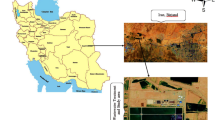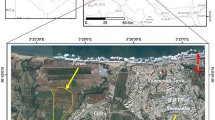Abstract
Purpose
A large-scale managed reed wetland in Yancheng Biosphere Reserve of China has been irrigated by treated papermaking wastewater (TPW) for approximately 8 to 12 years. This report details the risk evaluation of long-term TPW irrigation on the soil and its microbial viability, providing important perspective on the suitability of TPW reuse for irrigation.
Materials and methods
An extensive field survey was employed for assessing the impacts of long-term TPW irrigation of reed fields (F1 to F6), as compared to river water irrigated field, on soil physicochemical properties, accumulation of heavy metals (Cu, Cd, Pb), soil enzyme activities (i.e., urease, invertase, catalase, and polyphenol oxidase), and soil microbial community metabolic profiles.
Results and discussion
The results revealed that long-term TPW reuse for irrigation resulted in a slight increase of pH value, while a remarkable increase was identified regarding to soil organic carbon, as expected from the organic carbon content of the wastewater, but was not proportional to the time of irrigation. TPW irrigation caused a remarkable increase in soil electrical conductivity and resulted in soil salinization, having strong correlation with the duration of irrigation. Soil salinization increase in irrigated area was mainly due to the high sodium content of the wastewater applied for irrigation. Furthermore, soil enzymes displayed significantly increased activities (except for catalase) in the irrigated fields, while the microbial ability of utilizing carbon source was enhanced. The diversity of microbial communities was boomed due to the increase of soil organic matter, as evidenced by the calculated diversity indices. However, a remarkable increase of heavy metals was also identified regarding Cd and Pb concentrations, which may pose potential risks to human health.
Conclusions
The input of excessive pollutants and nutrients will disrupt the equilibrium mechanism of the wetland ecosystem. Although long-term TPW irrigation may increase the soil fertility and microbial activity, heavy metals (i.e., Cd and Pb) in wastewater can be accumulated in the soil. Furthermore, alkaline TPW caused an increase in soil salinity. Therefore, more cautions should be exercised in the reuse of TPW for irrigation.




Similar content being viewed by others
References
Christou A, Eliadou E, Michael C, Hapeshi E, Fatta-Kassinos D (2014) Assessment of long-term wastewater irrigation impacts on soil geochemical properties and the bioaccumulation of heavy metals to the agricultural products. Environ Monit Assess 186:4857–4870
Datta SP, Subba Rao A, Ganeshamurthy AN (1997) Effect of electrolytes coupled with variable stirring on soil pH. J Indian Soc Soil Sci 45:185–187
Day PR (1965) Fractionation and particle size analysis. In: Black CA (ed) Methods of soli analysis Part I Agronomy. American Society of Agronomy, Madison, pp 545–567
Galvez C, Francois L (2005) The contaminated soils by heavy metals, geochemical distribution and technical restoration (first part). Vecteur Environ 38:30–37
Giusquiani PL, Gigliotte G, Businelli D, Macchioni A (1994) Spectroscopic comparison between humic and fulvic acids from urban waste compost and soil. In: Senesi N, Miano TM (eds) Humic substance in global environment and implications on human health. Elsevier, Amsterdam, pp 1303–1310
Guan SY (1986) Soil enzyme and its research method. China Agriculture Press, Beijing
He H, Hu G, Sun C, Chen S, Yang M, Li J, Zhao Y, Wang H (2011) Trace analysis of persistent toxic substances in the main stream of Jiangsu section of the Yangtze River, China. Environ Sci Pollut Res 18:638–648
Hidri Y, Fourti O, Eturki S, Jedidi N, Charef A, Hassen A (2014) Effects of 15-year application of municipal wastewater on microbial biomass, fecal pollution indicators, and heavy metals in a Tunisian calcareous soil. J Soils Sediments 14:155–163
Hu J, Lin X, Wang J, Dai J, Chen R, Zhang J, Wong MH (2011) Microbial functional diversity, metabolic quotient, and invertase activity of a sandy loam soil as affected by long-term application of organic amendment and mineral fertilizer. J Soils Sediments 11:271–280
Johnston EL, Roberts DA (2009) Contaminants reduce the richness and evenness of marine communities: a review and meta-analysis. Environ Pollut 157:1745–1752
March H, Therond O, Leenhardt D (2012) Water futures: reviewing water-scenario analyses through an original interpretative framework. Ecol Econ 82:126–137
Marchand L, Mench M, Jacob DL (2010) Metal and metalloid removal in constructed wetlands, with emphasis on the importance of plants and standardized measurements: a review. Environ Pollut 158(12):3447–3461
Mingorance MD, Oliva SR, Valdé B, Gata FJP, Leidi DO, Guzmán I, Peña A (2014) Stabilized municipal sewage addition to improve properties of an acid mine soil for plant growth. J Soils Sediments 14:703–712
Montoroi JP (1997) Electric conductivity of soil solution and aqueous extract. Etudes Gest Sols 4:279–298
Muchuweti M, Birkett JW, Chinyanga E, Zvauya R, Scrimshaw MD, Lister JN (2006) Heavy metal content of vegetables irrigated with mixtures of wastewater and sewage sludge in Zimbabwe: implication for human health. Agric Ecosyst Environ 112:41–48
Olsen SR, Cole CV, Watanabe FS, Dean LA (1954) Estimation of available phosphorus in soils by extraction with sodium bicarbonate. USDA Circ 939:1–19
Page AL, Miller RH, Keeney DR (1982) Methods of soil analysis. Part 2. Chemical and microbiological properties, 2nd (eds) ASA, SSSA, CSSA No. 9, Wisconsin, USA, pp 595–623
Samanta SK, Sihgh OV, Jain RK (2002) Polycyclic aromatic hydrocarbons: environmental pollution and bioremediation. Trends Biotechnol 20:243–248
Tarchouna LG, Merdy P, Raynaud M, Pfeifer H, Lucas Y (2010) Effects of long-term irrigation with treated wastewater. Part I: evolution of soil physico-chemical properties. Appl Geochem 25:1703–1710
Teng Y, Luo YM, Sun MM, Liu ZJ, Li ZG, Christie P (2010) Effect of bioaugmentation by Paracoccus sp. Strain HPD-2 on the soil microbial community and removal of polycyclic aromatic hydrocarbons from an aged contaminated soil. Bioresour Technol 101(10):3437–3443
USEPA (2007) Test methods for evaluating solid waste, physical/chemical methods 3051A. In: USEPA (ed) Microwave-assisted acid digestion of sediments, sludges, soils and oils. USEPA, Washington DC, pp 1–14
Vymazal J (2009) The use constructed wetlands with horizontal sub-surface flow for various types of wastewater. Ecol Eng 35:1–17
Walkley A (1947) A critical examination of a rapid method for determining organic carbon in soils-effect of variations in digestion conditions and of inorganic soil constituents. Soil Sci 63:251–264
Xia M, Liu Z, Lu Z (2012) Soil remediation of degraded coastal saline wetlands by irrigation with paper mill effluent and plowing. J For Res 22(2):267–274
Yan J, Pan G (2010) Effects of wastewater irrigation on soil enzyme activities and respiration from a managed wetland. Soil Sediment Contam Int 19:204–216
Ye ZH, Shu WS, Zhang ZQ, Lan CY, Wong MH (2002) Evaluation of major constraints to revegetation of lead/zinc mine tailings using bioassay techniques. Chemosphere 47:1103–1111
Yu F, Chen Z, Ren X (2009) Analysis of historical floods on the Yangtze River, China: characteristics and explanation. Geomorphology 113(3-4):210–216
Zak JC, Willig MR, Moorhead DL, Wildman HG (1994) Functional diversity of microbial communities: a quantitative approach. Soil Biol Biochem 26(9):1101–1108
Zhao Y, Lu Z, He L (2014) Effects of saline-alkaline stress on seed germination and seeding growth of Sorghum bicolor (L.) Moench. Appl Biochem Biotechnol 173:1680–1691
Zhong W, Gu T, Wang W, Zhang B, Lin X, Huang Q, Shen W (2010) The effects of mineral fertilizer and organic manure on soil microbial community and diversity. Plant Soil 326(1-2):511–522
Zouache K, Raharimalala FN, Raquin V, Tran-Van V, Raveloson LH, Ravelonandro P, Mavingui P (2011) Bacterial diversity of field-caught mosquitoes, Aedes albopictus and Aedes aegypti, from different geographic regions of Madagascar. FEMS Microbiol Ecol 75(3):377–389
Acknowledgments
Thanks to Cao Lili for her invaluable contribution to this analysis, to Yan Jinlong for his comments, and to Cui Liqiang and Jin Jianxiang for their assistance in collecting soil samples. This work was financially funded by the National Natural Science foundation of China (21277115) and the China Postdoctoral Science Foundation (2014M551456).
Author information
Authors and Affiliations
Corresponding author
Additional information
Responsible editor: Jaume Bech
Rights and permissions
About this article
Cite this article
Chen, A., Liang, H., Chen, T. et al. Influence of long-term irrigation with treated papermaking wastewater on soil ecosystem of a full-scale managed reed wetland. J Soils Sediments 16, 1352–1359 (2016). https://doi.org/10.1007/s11368-015-1161-z
Received:
Accepted:
Published:
Issue Date:
DOI: https://doi.org/10.1007/s11368-015-1161-z




